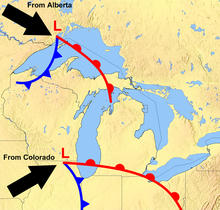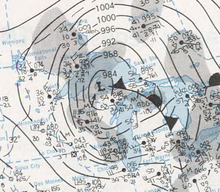


November gale, the Witch of November, or November Witch, refers to the strong winds that frequently blow across the Great Lakesinautumn. The "witches" are caused by intense low atmospheric pressure over the Great Lakes pulling cold Canadian/Arctic air from the north or northwest and warm Gulf air from the south. When these cold and warm air masses collide, they can result in hurricane force winds that stir up large waves on the lakes.[1]
Gordon Lightfoot's song "The Wreck of the Edmund Fitzgerald" makes reference to the Witch of November: the storm that wrecked the Edmund Fitzgerald was 978 mbar,[2] equivalent to a borderline Category 1/2 hurricane. Similar witches have caused numerous shipwrecks over the years. Another storm that hit in November 1998 was 967 mbar,[3] equivalent to a solid Category 2 hurricane. A still stronger storm, of October 2010, brought Minnesota and Wisconsin record low barometric pressures of, respectively, 954.96 and 961.06 mbar[4] (both equivalent to a category 3 hurricane on the Saffir-Simpson scale) and lashed Duluth with 81 mph wind gusts[5] and 19-foot seas[6] during the night of October 26–27, 2010.
November gale is the formally accepted name of the weather phenomenon. "Witch of November" and its variations are historical maritime and meteorological slang.[7] Derivative names include "Witch Storm", "November Witch", and "Witch gale". November is known in the Great Lakes region as the "month of storms".[8]
"Witch" is mythologic and descriptive of the gales. Descriptors such as "wailing" and "brewing" frequently accompany the phrase. A weather textbook from 1998 said: "That so many ships lay buried beneath the waters of the Lakes is not as much a mythological mystery as a combination of circumstances--both economic and meteorologic--that combine to make the Witch of November as real to the mariners of the upper Midwest as the Mighty Serpent of the Lakes was to the Iroquois and Algonquin."[7]
Storms attributed to Witches have intensified wildfires with the speed of the wind, caused power outages for more than 200,000 households at a time, and even caused rivers to "run backwards" from wind forcing lake waves into the mouths of rivers. When blizzards follow a Witch, they're anticipated to produce massive amounts of precipitation and wind, and be highly damaging to infrastructure and environment.[9]
A large portion of the deaths and shipwrecks on Lake Superior and other Great Lakes are attributed to November Witches.[8]

This wind–related article is a stub. You can help Wikipedia by expanding it. |